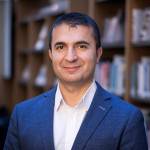This is the overall, main finding of the new comparative research report launched in Oslo this January, led by senior researcher at Oslo Metropolitan University (OsloMet), Vilde Hernes.
Hernes, who is with the Norwegian Institute for Urban and Regional Research (NIBR) at OsloMet, is the project manager behind a unique research report that compares the responses of eight European countries to the high influxes of protection seekers in 2015-2016 and in 2022-2023.
It includes updated analysis of policy responses up until June 2023, and it is the first report of its kind.
Restrictive “race to the bottom” after 2015
"All the countries became more restrictive after 2015", said Hernes.
The restrictions came in many different policy-areas, such as protection permits, legal assistance, family reunification and financial assistance, to name but a few.
"However, these restrictions were not part of a unified response across Europe, but rather – as earlier studies have described it – a “national race to the bottom”, where countries competed to have the most restrictive policies, so as not to become a more attractive destination than others", said Hernes.
In 2022, the researchers found a much more unified response to the high number of people fleeing Ukraine, at least when it comes to granting protection.
"The EU countries activated the temporary protection Directive, which gave Ukrainians temporary protection up to three years. Denmark and Norway have made national legislation that largely mirror this", said Hernes.

A dual approach to Ukrainians
"We see a more liberal trend when it comes to registration and access. But integration measures have been more restrictive."
View Vilde Hernes launch the report here (film.oslomet.no)The Nordic countries channelled Ukrainians through the regular asylum system where one had to formally apply for protection, although the collective protection simplified the procedure and there was elements of online registrations and automatic processing of applications.
Germany, Poland and Austria did not channel them through the regular asylum system, but made registration procedures where one was granted rights upon registration, or just by having a Ukrainian passport.
The UK is the only outlier in this respect, as the only country who is not part of the Schengen agreement.
"They have not implemented temporary collective protection mirroring the EU, but rather introduced three different visa schemes particularly aimed at Ukrainians", said Hernes.
Dual approach to Ukrainians
In spite of easier access, Hernes and her team found that – contrary to popular perception – Ukrainians are not treated better than other protection seekers across the board.
"There is a dual approach to Ukrainians seeking protection. On the one hand, we see a more liberal trend when it comes to registration and access-practices", said Hernes. She added:
"The introduction of collective, temporary permits was in itself an easing of requirements, and made the path to granted protection shorter and less extensive for Ukrainians, as it did not require an individual assessment."
Ukrainians also generally had the right to return to Ukraine temporarily without losing their protection -status, the right to find their own accommodation and the right to work.
However, on the other hand, policies on integration measures, financial assistance and healthcare have been more restrictive for Ukrainians.
"Ukrainians have, as of today, no path to permanent residency, and they are often offered less assistance in the host country than people with a refugee-status", said Hernes.
"For instance, in Sweden, Ukrainians granted temporary collective protection are still only entitled to emergency healthcare. They continue to be covered by the same rights as asylum-seekers, even after they are granted protection", added Hernes.
The result is a unique comparative analysis, both in format and scope, and ground-breaking in an international context.– Halwan Ibrahim, assistant director at IMDi

Shift in the public debate
This makes life a lot more uncertain for Ukrainians, she argues. And it will only get more uncertain.
"Even though there has been a more unified response to the influx of Ukrainians, there is only one year left of the tree year protection permit. And there is still a lot of uncertainty as to how long the war in Ukraine will last, and how many more will be seeking protection. That may lead to more restrictions", said Hernes.
For example, Norway has received about 72.000 Ukrainians. They now make up one per cent of the entire population.
"Here we now see a shift in the public debate, with municipalities saying they don’t have enough housing or capacity to administer all those granted protection, and some are calling for more restrictions. It may be that we are on the brink of another “race to the bottom”, like we saw in 2015", said Hernes.
Ground-breaking in an international context
The research project was commissioned by The Directorate of Integration and Diversity (IMDi) in Norway. IMDi is the government agency, under the Ministry of Labour and Social Inclusion, responsible for implementing government integration policies.
"An important part of our work is to ensure that our policies are based on knowledge and research", said Halwan Ibrahim, assistant director at IMDi.
The idea behind this project came in 2022, when they saw the situation facing Europe after the Russian full-scale invasion of Ukraine, with high influxes of asylum seekers.
"We saw the need to gather more information and gain insights on how other countries responded, and what we could learn from them", said Ibrahim.
He added that the project set a high standard, both in knowledge producing and in the methods used.
"The result is a unique comparative analysis, both in format and scope, and ground-breaking in an international context", said Ibrahim.
Read the report
Governance and policy changes during times of high influxes of protection seekers. A comparative governance and policy analysis in eight European countries, 2015-June 2023.
You will find the report here (oda.oslomet.no)Asylum inflows to European countries
- Have varied significantly over the past ten years, with 2015/16 and 2022/23 being the absolute peak years.
- Many of the countries included in this research-project, such as Germany, Sweden, Austria, and Norway, were among the countries that received the highest number of asylum seekers arriving in 2015/16 to Europe, both in absolute numbers and relative to their populations.
- For persons granted protection in Europe throughout 2015 to June 2023, the main sending countries are Syria, Afghanistan, Iraq, Eritrea, and since 2022, Ukraine.
- While most protection seekers from Ukraine falls within the EU or national protection schemes for collective protection, for other groups of asylum seekers, the recognition rates for the eight countries have been about 50 per cent, but there are very large differences in recognition rates depending on the country of origin.
- While almost all applicants from Syria and Eritrea received protection, only half of those from Afghanistan, Iran, and Iraq did, and from other countries, almost three out of four got their application for protection rejected.
- Although most of the countries studied have experienced substantial increases in the number of protection seekers, there are still large variations.
- Sweden has generally received a disproportionally larger share than other European countries, but this has declined over the last three years. Now they receive a lower share than other countries.
- As a contrast, Poland received the lowest share of protection seekers up until 2022. After 2022 however, they received – by far – the highest number of persons fleeing Ukraine, with nearly 1,5 million Ukrainians seeking protection in Poland by the end of 2023.



